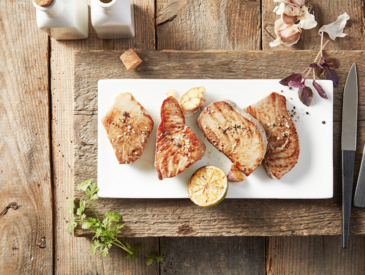Handling of tuna is a challenge for fish-processing companies. One that requires tact and knowledge of raw goods. Especially the thawing of tuna is complex: Temperature and ventilation must be set precisely so that no waste is produced, and the quality of the valuable fish remains optimal. The Bremerhaven company TFE #TheFishExperts is now using the expertise acquired over many years by the Institute for Microsensors, -actuators and -systems (IMSAS) at the University of Bremen for the development of food monitoring sensors. In the Conservation of Resources in the Tuna Supply Chain (“Ressourcenschonung in der Supply Chain von Thunfisch”) project, a sensor, with which one can exactly determine when tuna has thawed to its core, is to be developed.
Frozen at -18 Degrees for Transport
TFE #TheFishExperts imports MSC certified wild tuna and processes and packs said fish for sale in “bite-sized” steaks. Only the filet pieces – so-called loins – of the yellow fin tuna are processed. The tuna can grow up to be 2.4 meters long and can weigh up to 200 kilograms. The tuna is already frozen at -18 degrees on board the fishing vessels. Whilst frozen they are sawn and transported to Germany in an environmentally-friendly manner via ship.
In order to further process the high-quality fish, the loins, which are four to six kilograms heavy, must be thawed by TFE. The thawing must occur in optimum relation to the time and the loss of weight. The time factor plays a decisive role, especially in terms of bacteria forming. The greater the shortening of the timeframe, the fresher the fish remains – which in turn extends its shelf life. But short thawing processes are also much more efficient with regards to energy consumption. The topic of fluid loss does not only make itself seen in terms of finances, but also in terms of taste, as the fluid in tuna additionally functions as a flavor carrier.
Aim: Clear Reduction of Waste
The art is to set the temperature just so that the loins are thawed to their core, but the outside is not warmed too much. “Everything above 2 degrees is a catastrophe for our tuna,” says TFE quality manager Dorte Weinrich. “In the worst case, mistakes in the thawing process lead to a proportion of waste. And that simply should not happen in a food-processing company.”
The thawing process is thus an important step that is now to be optimized with the help of IMSAS. With funding from the European Regional Development Fund (ERDF) and Bremen State, economy and science can work together expediently. The project is being financed as part of the Promotion of Application-Oriented Environmental Technologies (“Förderung anwendungsnaher Umwelttechniken”) (PFAU) program. BIS Bremerhavener Gesellschaft für Investitionsförderung und Stadtentwicklung mbH is the sponsor.
IMSAS: Experience with Food Monitoring with Sensors
The required expertise is available at the university institute: “We have been working on the monitoring of food with sensors for a while now, for example the monitoring of bananas during sea transport and apples in cooling stores,” says Professor Walter Lang, director of the Institute for Microsensors, -actuators and -systems. “This was a new, but very interesting research focus for us, which we would like to expand. Food is a scarce and precious commodity, of which too much is still being wasted. Sensors help to recognize problems as early as possible and to control processes precisely. In this way, waste and losses can be avoided.”
“We are testing different approaches,” explains Dr.-Ing. Reiner Jedermann, and IMSAS researcher in the field of food logistics. “Upon freezing, many physical characteristics of water change, for example, the speed of ultrasound waves. We want to use such effects.” The system will be supplemented with a mobile network of temperature sensors. Additional support is being provided by the company Sequid, who already put new technology for high frequency measuring of food onto the market 10 years ago. “We cannot yet say which sensor will win in the end. Our vision is a system that thaws the goods as gently as possible and right on time for the start of production.”
Further Information:
www.uni-bremen.de/en/imsas
www.fish-experts.com/en/
https://sequid.de/en/
www.uni-bremen.de/en/
Contact:
Dr.-Ing. Reiner Jedermann
IMSAS - Institute for Microsensors, -actuators and -systems
University of Bremen
Phone: +49 (0)421 218-662603
Email: rjedermannprotect me ?!imsas.uni-bremenprotect me ?!.de

